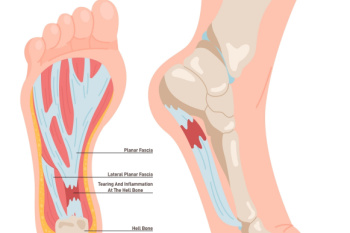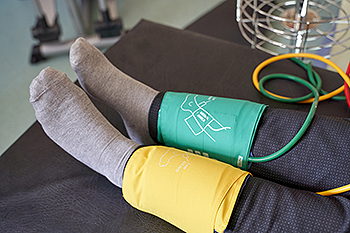Items filtered by date: May 2024
Diagnosis and Symptoms of an Ankle Fracture

An ankle fracture occurs when one or more of the bones surrounding the ankle joint break, typically due to trauma or excessive force. Diagnosis of an ankle fracture begins with a thorough physical examination by a podiatrist, including assessment of symptoms and a review of the injury's circumstances. Imaging tests such as X-rays are then used to confirm the diagnosis and determine the extent of the fracture. Symptoms of an ankle fracture often include severe pain, swelling, bruising, and difficulty bearing weight on the affected foot. In some cases, the ankle may appear deformed or out of alignment. Additionally, individuals may experience a limited range of motion and tenderness to touch surrounding the ankle joint. Prompt diagnosis and appropriate treatment are essential in managing ankle fractures effectively. If you have broken your ankle, it is suggested that you consult a podiatrist who can discuss which treatment options are right for you.
Broken ankles need immediate treatment. If you are seeking treatment, contact one of our podiatrists from Pima Foot and Ankle Surgery. Our doctors can provide the care you need to keep you pain-free and on your feet.
Broken Ankles
A broken ankle is experienced when a person fractures their tibia or fibula in the lower leg and ankle area. Both of these bones are attached at the bottom of the leg and combine to form what we know to be our ankle.
When a physician is referring to a break of the ankle, he or she is usually referring to a break in the area where the tibia and fibula are joined to create our ankle joint. Ankles are more prone to fractures because the ankle is an area that suffers a lot of pressure and stress. There are some obvious signs when a person experiences a fractured ankle, and the following symptoms may be present.
Symptoms of a Fractured Ankle
- Excessive pain when the area is touched or when any pressure is placed on the ankle
- Swelling around the area
- Bruising of the area
- Area appears to be deformed
If you suspect an ankle fracture, it is recommended to seek treatment as soon as possible. The sooner you have your podiatrist diagnose the fracture, the quicker you’ll be on the way towards recovery.
If you have any questions, please feel free to contact our offices located in . We offer the newest diagnostic and treatment technologies for all your foot care needs.
Causes and Symptoms of Heel Fissures

Heel fissures are cracks in the skin over your heels that can range from minor discomfort to serious health concerns. Symptoms include can mild discoloration, thickening of the skin, visible splitting of the skin, and bleeding. Without treatment, heel fissures can worsen, leading to open wounds, pain, and even deep ulcers susceptible to infections like cellulitis. Dry skin on the heels is a primary cause of fissures, worsened by conditions such as diabetes, eczema, and fungal infections. Due to damaged foot nerves and decreased moisture, diabetic patients are particularly at risk for heel fissures that progress into non-healing ulcers. To manage symptoms of heel fissures, regular moisturizing is recommended, in addition to exfoliation with alpha hydroxy acids or urea-based creams. If the heel fissures continue to worsen, seeking medical attention from a podiatrist is suggested. This foot doctor can provide specialized debridement to remove thickened skin and prescribe medication to combat infections. If dry skin on your feet is causing problems like heel fissures, it is suggested that you schedule an appointment with a podiatrist.
Cracked heels are unsightly and can cause further damage to your shoes and feet. If you have any concerns, contact one of our podiatrists from Pima Foot and Ankle Surgery. Our doctors can provide the care you need to keep you pain-free and on your feet.
Cracked Heels
Cracked heels appear unappealing and can make it harder for you walk around in sandals. Aside from looking unpleasant, cracked heels can also tear stockings, socks, and wear out your shoes. There are several methods to help restore a cracked heel and prevent further damage.
How Do You Get Them?
Dry skin is the number one culprit in creating cracked heels. Many athletes, walkers, joggers, and even swimmers suffer from cracked heels. Age and skin oil production play a role to getting cracked heels as well.
Promote Healing
Over the counter medicines can help, especially for those that need instant relief or who suffer from chronic dry feet.
Wear Socks – Wearing socks with medicated creams helps lock in moisture.
Moisturizers – Applying both day and night will help alleviate dryness which causes cracking.
Pumice Stones – These exfoliate and remove dead skin, which allows for smoother moisturizer application and better absorption into the skin.
Change in Diet
Eating healthy with a well-balanced diet will give the skin a fresh and radiant look. Your body responds to the kinds of food you ingest. Omega-3 fatty acids and zinc supplements can also revitalize skin tissue.
Most importantly, seek professional help if unsure how to proceed in treating cracked heels. A podiatrist will help you with any questions or information needed.
If you have any questions, please feel free to contact our offices located in . We offer the newest diagnostic and treatment technologies for all your foot care needs.
Stop Your Toenail Fungus
How Athlete’s Can Safeguard Against Plantar Fasciitis

Athletes employ various tactics to shield themselves from the discomfort of plantar fasciitis, a common ailment among active individuals. Proper footwear selection plays a pivotal role, with athletes opting for supportive shoes that offer ample cushioning and stability. Additionally, incorporating stretching and strengthening exercises into their routine helps maintain flexibility and strength in the muscles and ligaments of the feet and lower legs, reducing the risk of strain and injury. Gradual progression in training intensity and duration also proves beneficial, allowing the body to adapt gradually to increased demands and minimizing the likelihood of overuse injuries like plantar fasciitis. Podiatrists may prescribe orthotic inserts or arch supports that can provide additional support and alignment for the feet. If you have heel pain, it is suggested that you consult with this type of doctor who can treat plantar fasciitis, and provide effective preventive solutions.
Plantar fasciitis can be very painful and inconvenient. If you are experiencing heel pain or symptoms of plantar fasciitis, contact one of our podiatrists from Pima Foot and Ankle Surgery. Our doctors can provide the care you need to keep you pain-free and on your feet.
What Is Plantar Fasciitis?
Plantar fasciitis is the inflammation of the thick band of tissue that runs along the bottom of your foot, known as the plantar fascia, and causes mild to severe heel pain.
What Causes Plantar Fasciitis?
- Excessive running
- Non-supportive shoes
- Overpronation
- Repeated stretching and tearing of the plantar fascia
How Can It Be Treated?
- Conservative measures – anti-inflammatories, ice packs, stretching exercises, physical therapy, orthotic devices
- Shockwave therapy – sound waves are sent to the affected area to facilitate healing and are usually used for chronic cases of plantar fasciitis
- Surgery – usually only used as a last resort when all else fails. The plantar fascia can be surgically detached from the heel
While very treatable, plantar fasciitis is definitely not something that should be ignored. Especially in severe cases, speaking to your doctor right away is highly recommended to avoid complications and severe heel pain. Your podiatrist can work with you to provide the appropriate treatment options tailored to your condition.
If you have any questions please feel free to contact our offices located in . We offer the newest diagnostic and treatment technologies for all your foot and ankle needs.
Peripheral Artery Disease and Diabetes
 Peripheral artery disease, or PAD, is a condition where the arteries that supply blood to the legs and feet become narrowed due to plaque buildup. Diabetes significantly increases the risk of developing this condition. High blood sugar levels contribute to the accumulation of fatty deposits in the blood vessels, which can harden and reduce blood flow. This process, known as atherosclerosis, is more common in diabetes patients due to the chronic high glucose levels that damage the blood vessel walls. Symptoms of PAD include pain, cramping, or heaviness in the legs and feet during activities like walking. Complications like ulcers, which often appear on the feet, can lead to serious infections. Regular check-ups with a podiatrist, or foot doctor, are important to prevent any issues and manage foot and lower leg health. If you have symptoms of peripheral artery disease, it is suggested that you make an appointment with a podiatrist today.
Peripheral artery disease, or PAD, is a condition where the arteries that supply blood to the legs and feet become narrowed due to plaque buildup. Diabetes significantly increases the risk of developing this condition. High blood sugar levels contribute to the accumulation of fatty deposits in the blood vessels, which can harden and reduce blood flow. This process, known as atherosclerosis, is more common in diabetes patients due to the chronic high glucose levels that damage the blood vessel walls. Symptoms of PAD include pain, cramping, or heaviness in the legs and feet during activities like walking. Complications like ulcers, which often appear on the feet, can lead to serious infections. Regular check-ups with a podiatrist, or foot doctor, are important to prevent any issues and manage foot and lower leg health. If you have symptoms of peripheral artery disease, it is suggested that you make an appointment with a podiatrist today.
Peripheral artery disease can pose a serious risk to your health. It can increase the risk of stroke and heart attack. If you have symptoms of peripheral artery disease, consult with one of our podiatrists from Pima Foot and Ankle Surgery. Our doctors will assess your condition and provide you with quality foot and ankle treatment.
Peripheral artery disease (PAD) is when arteries are constricted due to plaque (fatty deposits) build-up. This results in less blood flow to the legs and other extremities. The main cause of PAD is atherosclerosis, in which plaque builds up in the arteries.
Symptoms
Symptoms of PAD include:
- Claudication (leg pain from walking)
- Numbness in legs
- Decrease in growth of leg hair and toenails
- Paleness of the skin
- Erectile dysfunction
- Sores and wounds on legs and feet that won’t heal
- Coldness in one leg
It is important to note that a majority of individuals never show any symptoms of PAD.
Diagnosis
While PAD occurs in the legs and arteries, Podiatrists can diagnose PAD. Podiatrists utilize a test called an ankle-brachial index (ABI). An ABI test compares blood pressure in your arm to you ankle to see if any abnormality occurs. Ultrasound and imaging devices may also be used.
Treatment
Fortunately, lifestyle changes such as maintaining a healthy diet, exercising, managing cholesterol and blood sugar levels, and quitting smoking, can all treat PAD. Medications that prevent clots from occurring can be prescribed. Finally, in some cases, surgery may be recommended.
If you have any questions, please feel free to contact our offices located in . We offer the newest diagnostic and treatment technologies for all your foot care needs.

